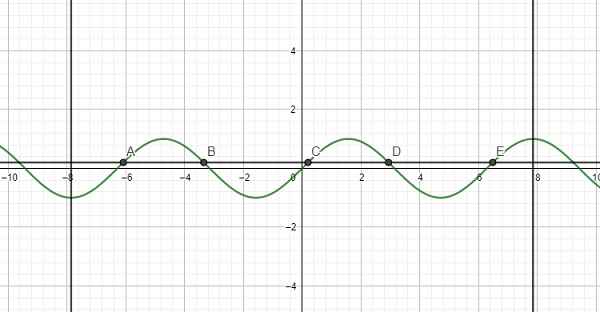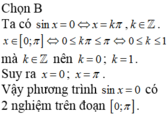
Hãy nhập câu hỏi của bạn vào đây, nếu là tài khoản VIP, bạn sẽ được ưu tiên trả lời.


Ta có
\(\begin{array}{l}\sin x{\rm{ }} = {\rm{ }}0\\ \Leftrightarrow \sin x{\rm{ }} = {\rm{ sin 0}}\\ \Leftrightarrow x{\rm{ }} = {\rm{ }}k\pi ;k \in Z\end{array}\)
Mà \(x \in \left[ {0;10\pi } \right]\) nên
\(\begin{array}{l}0 \le k\pi \le 10\pi \\ \Rightarrow 0 \le k \le 10\end{array}\)
Lại có \(k \in Z\) suy ra \(k \in \left\{ {0;1;2;3;4;5;6;7;8;9;10} \right\}\)
Vậy phương trình đã cho có số nghiệm là 11.
Chọn D

\(0< \dfrac{1}{2018}< 1\)
Kẻ 1 đường thẳng nằm ngang nằm giữa \(y=0\) và \(y=1\) ta thấy cắt đồ thị tại 5 điểm trên đoạn đã cho
\(\Rightarrow\) Pt có 5 nghiệm


\(\Leftrightarrow3sinx-4sin^3x+4cos^3x-3cosx+2cosx=0\)
\(\Leftrightarrow3sinx-cosx-4sin^3x+4cos^3x=0\)
Với \(cosx=0\) ko phải nghiệm, với \(cosx\ne0\) chia 2 vế cho \(cos^3x\)
\(\Leftrightarrow3tanx\left(1+tan^2x\right)-\left(1+tan^2x\right)-4tan^3x+4=0\)
\(\Leftrightarrow-tan^3x-tan^2x+3tanx+3=0\)
\(\Leftrightarrow-tan^2x\left(tanx+1\right)+3\left(tanx+1\right)=0\)
\(\Leftrightarrow\left(tanx+1\right)\left(3-tan^2x\right)=0\)
\(\Leftrightarrow\left[{}\begin{matrix}tanx=-1\\tanx=\sqrt{3}\\tanx=-\sqrt{3}\end{matrix}\right.\)
Tới đây chắc bạn hoàn thành được phần còn lại


1.
\(cos2x-3cosx+2=0\)
\(\Leftrightarrow2cos^2x-3cosx+1=0\)
\(\Leftrightarrow\left[{}\begin{matrix}cosx=1\\cosx=\dfrac{1}{2}\end{matrix}\right.\)
\(\Leftrightarrow\left[{}\begin{matrix}x=k2\pi\\x=\pm\dfrac{\pi}{3}+k2\pi\end{matrix}\right.\)
\(x=k2\pi\in\left[\dfrac{\pi}{4};\dfrac{7\pi}{4}\right]\Rightarrow\) không có nghiệm x thuộc đoạn
\(x=\pm\dfrac{\pi}{3}+k2\pi\in\left[\dfrac{\pi}{4};\dfrac{7\pi}{4}\right]\Rightarrow x_1=\dfrac{\pi}{3};x_2=\dfrac{5\pi}{3}\)
\(\Rightarrow P=x_1.x_2=\dfrac{5\pi^2}{9}\)
2.
\(pt\Leftrightarrow\left(cos3x-m+2\right)\left(2cos3x-1\right)=0\)
\(\Leftrightarrow\left[{}\begin{matrix}cos3x=\dfrac{1}{2}\left(1\right)\\cos3x=m-2\left(2\right)\end{matrix}\right.\)
\(\left(1\right)\Leftrightarrow x=\pm\dfrac{\pi}{9}+\dfrac{k2\pi}{3}\)
Ta có: \(x=\pm\dfrac{\pi}{9}+\dfrac{k2\pi}{3}\in\left(-\dfrac{\pi}{6};\dfrac{\pi}{3}\right)\Rightarrow x=\pm\dfrac{\pi}{9}\)
Yêu cầu bài toán thỏa mãn khi \(\left(2\right)\) có nghiệm duy nhất thuộc \(\left(-\dfrac{\pi}{6};\dfrac{\pi}{3}\right)\)
\(\Leftrightarrow\left[{}\begin{matrix}m-2=0\\m-2=1\\m-2=-1\end{matrix}\right.\Leftrightarrow\left[{}\begin{matrix}m=2\\m=3\\m=1\end{matrix}\right.\)
TH1: \(m=2\)
\(\left(2\right)\Leftrightarrow cos3x=0\Leftrightarrow x=\dfrac{\pi}{6}+\dfrac{k2\pi}{3}\in\left(-\dfrac{\pi}{6};\dfrac{\pi}{3}\right)\Rightarrow x=\dfrac{\pi}{6}\left(tm\right)\)
\(\Rightarrow m=2\) thỏa mãn yêu cầu bài toán
TH2: \(m=3\)
\(\left(2\right)\Leftrightarrow cos3x=0\Leftrightarrow x=\dfrac{k2\pi}{3}\in\left(-\dfrac{\pi}{6};\dfrac{\pi}{3}\right)\Rightarrow x=0\left(tm\right)\)
\(\Rightarrow m=3\) thỏa mãn yêu cầu bài toán
TH3: \(m=1\)
\(\left(2\right)\Leftrightarrow cos3x=-1\Leftrightarrow x=\dfrac{\pi}{3}+\dfrac{k2\pi}{3}\in\left(-\dfrac{\pi}{6};\dfrac{\pi}{3}\right)\Rightarrow\left[{}\begin{matrix}x=\pm\dfrac{1}{3}\\x=-1\\x=-\dfrac{5}{3}\end{matrix}\right.\)
\(\Rightarrow m=2\) không thỏa mãn yêu cầu bài toán
Vậy \(m=2;m=3\)

=>2cos2x=pi(loại) hoặc sin x-cosx=0
=>sin x-cosx=0
=>sin(x-pi/4)=0
=>x-pi/4=kpi
=>x=kpi+pi/4
mà x\(\in\left[-pi;pi\right]\)
nên \(x\in\left\{\dfrac{pi}{4};-\dfrac{3}{4}pi\right\}\)
=> D

\(cos3x=sinx\)
\(\Leftrightarrow cos3x=cos\left(\dfrac{\pi}{2}-x\right)\)
\(\Leftrightarrow\left[{}\begin{matrix}3x=\dfrac{\pi}{2}-x+k2\pi\\3x=x-\dfrac{\pi}{2}+k2\pi\end{matrix}\right.\)
\(\Leftrightarrow\left[{}\begin{matrix}x=\dfrac{\pi}{8}+\dfrac{k\pi}{2}\\x=-\dfrac{\pi}{4}+k\pi\end{matrix}\right.\)
\(\Rightarrow x=\left\{\dfrac{\pi}{8};\dfrac{5\pi}{8};\dfrac{3\pi}{4}\right\}\)